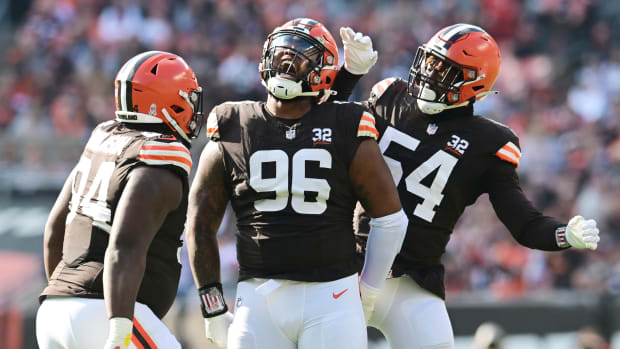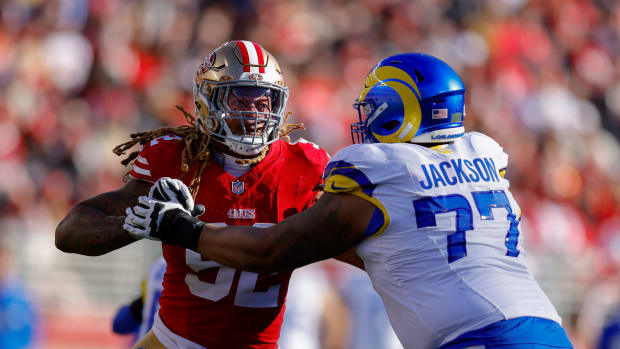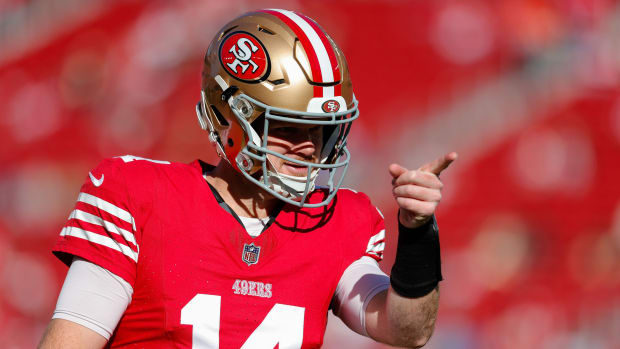When NFL Contracts Want a Pound of Flesh
Some observations from the past week, using my experiences to add some perspective…
The Weight of Expectations
I cringed when I saw reports that Eddie Lacy’s deal with the Seahawks includes weight clauses, with maximum earnings of $385,000. I get that he has struggled with weight (he reportedly weighed in at 267 last week), but I learned the hard way—as an agent and team executive—that these clauses are counterproductive and detrimental to a player’s health.
In the days, hours and even minutes before scheduled weigh-ins, I discovered that players would sit in saunas and steam rooms, run on the treadmill in rubber suits and, among other tactics, use diuretics to drain water weight. Whether they made their target weight or not, these methods would deplete them of strength and glycogen storage for days or weeks to come. Teams should have evolved their approach by now; they could use measurements for body fat or take DEXA scans, which measure bone density. These methods would be more productive and beneficial for both the team and player. This is an area ripe for change.
Packer Principles
The Packers said goodbye to Eddie Lacy, Jared Cook, Julius Peppers, TJ Lang and JC Tretter in free agency this offseason. The departures have prompted the same question I’ve heard for almost 20 years: Why isn’t Green Bay more aggressive in retaining players or adding new ones? I always answer this question by asking another: “What part of Ted Thompson do you not understand?”
I have known Ted since the day I started with the Packers, in February 1999, when Ron Wolf told me to sit in an office with a white-haired guy who didn’t say much (that would be Ted). Ted believed then, as he does now, that free-agent waters are dangerous. He wonders, as I always did, about players whose incumbent teams did not go to great lengths to sign them. The Packers’ resisted paying “retail” for the players mentioned above, yet gave a stunning deal to linebacker Nick Perry and surprised us with a top-of-market contract for tight end Martellus Bennett. We were always willing to pay to retain core players and even shock the league now and then with a marquee free agent, such as Charles Woodson and Julius Peppers.
Many teams seem to change plans and spending patterns from year to year; the Packers are who they are. What part of Ted Thompson do you not understand?
Marshawn Matters
Having sat for years between John Schneider and Reggie McKenzie, now the general managers for the Seahawks and Raiders, I feel like I should broker a Marshawn Lynch trade between the two. They were former colleagues of mine in Green Bay, and I remember how frustrated both were when the Bills drafted Lynch ahead of us in the first round of the 2007 draft.
A trade, of course, isn’t as easy as it may seem. Lynch had an existing contract when he retired, which was tolled (frozen) when he went on the Seahawks’ reserve/retired list. Lynch can petition for reinstatement, at which time the Seahawks have to either activate him to their 90-man roster or release him. Although the Seahawks would not want to keep him, because he has a high salary and no interest in playing for them, Seattle could activate him to engage in trade negotiations. They could also release Lynch from the reserve/retired list, allowing him to do what he pleases. It will be intriguing to watch two general managers who are as close as any in the NFL potentially working out this transaction.
Funny Money
As Peter King pointed out yesterday, NFL free agency has reduced to a crawl barely 10 days into it, even with teams having roughly $750 million in collective salary cap room available. A couple points to reset any spending expectations here:
First, spending minimums are accounted every four years, with the most recent accounting having been completed after last season. They must spend 89% of the cap over a four-year inspection period, but the next accounting is after the 2020 season.
Perhaps more importantly, these minimums are based on the unadjusted cap ($167 million this year) rather than team adjusted caps that include amounts rolled over from previous years. In other words, to spend 89% of the unadjusted cap, approximately $150 million, teams with adjusted (true) cap exceeding $200 million (Browns, Jaguars, 49ers, Titans, etc) only have to spend about 75% of their cap for the minimum thresholds.
Ware Wisdom
A week ago Sunday I was in Austin, Texas, at the South By Southwest Conference. I was there to speak about sports and gambling, but I also had a chance to listen to an athlete panel that included DeMarcus Ware. He spoke compellingly about proper care and training both body and mind. He even dished some simple advice such as, “If your stomach hurts when you eat ice cream, then don’t eat ice cream.” As a fitness and nutrition nerd, I was in my element. The next day Ware retired, now keeping his elite fitness intact for himself, not for a team.
His retirement brings me back to the Packers’ War Room during the first round of the 2005 draft. Before selecting Aaron Rodgers later in the round, there was an audible groan when the Cowboys picked Ware, one of our targeted players. The NFL could be a different place today if somehow Ware had still been on the board when our pick came up.
Bang for the Buc
As readers of this space know, I have been critical of teams’ “credit card” salary cap management strategy of overusing prorated signing bonuses, whether initially in contracts or in future renegotiations. It is a vicious cycle that prevents teams from playing with a full deck in team building. I much prefer a proven “pay as you go” philosophy that 1) matches cap and cash as evenly as possible and 2) leaves behind little to no leftover cap charges when there might be a separation (which there always is). One team drawing my admiration here is the Buccaneers.
The free-agent contracts for DeSean Jackson and Chris Baker match cap and cash evenly—Jackson has $12.5 million this year in both categories, Baker has $6 million— and no (zero) proration. If they are “one and done,” before nonguaranteed salaries in 2018 and 2019, they will leave behind a no (zero) cap charge (by comparison, Tony Romo will leave behind $19 million on the Cowboys’ cap). Bravo to the Bucs; “pay as you go” keeps teams ahead of the curve in NFL cap management.
Good Luck Dwight
Like many others of a certain age who remember “The Catch” so vividly, my heart goes out to Dwight Clark, who publicly acknowledged his battle with ALS. I have seen the ravaging power of this disease up close with a former family member; with Kevin Turner, a face of the NFL concussion litigation who passed away this year; and with Steve Gleason, who turned 40 on Sunday.
Many may not remember, but Clark was general manager of the reincarnated Cleveland Browns, coming into the NFL as an executive in the same year I did, 1999, and serving until 2002. I always enjoyed being around Clark at league meetings, where he was an energetic and refreshing presence. As so many have already done, I’m wishing him strength in his battle.
Question? Comment? Story idea? Let us know at talkback@themmqb.com





































